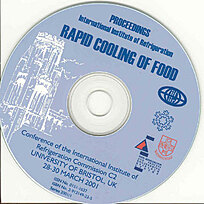
Document IIF
Mise au point d'équipements pour la congélation rapide.
Development of equipment for rapid freezing.
Auteurs : EVERINGTON D. W.
Résumé
In conventional designs of air blast tunnels, the use of high velocity air to reduce freezing times is restricted because normally the same volume of air circulates through the evaporator coil and then across the product. The air velocity over the product is determined by the ratio of the evaporator's face velocity to the free area across the product. Generally, the pressure drop across the evaporator is dominant in the overall pressure drop and therefore restricts the volume of air in circulation. To achieve an economical balance in absorbed fan power, face velocities through the evaporator coil are limited to between 3 and 4 m/s. High air velocities in the region of 10 to 20 m/s can only be achieved over the products if the ratio of the evaporator's face area to the free area over the product is large. To avoid high pressure drops over the evaporator a dual air system can be used which uses two sets of fans, one set providing an optimum velocity across the evaporator, the other to provide a high air velocity over the product. In practice, this method enables air velocities of between 10 and 30 m/s to be used for freezing, which can drastically reduce the residence time in the tunnels. Compared to conventional tunnels, very high velocity air, coupled with air temperatures in the region of -45 to -40 °C, can achieve freezing times comparable to liquid nitrogen tunnels, which significantly reduces capital costs.
Documents disponibles
Format PDF
Pages : 2001-1
Disponible
Prix public
20 €
Prix membre*
Gratuit
* meilleur tarif applicable selon le type d'adhésion (voir le détail des avantages des adhésions individuelles et collectives)
Détails
- Titre original : Development of equipment for rapid freezing.
- Identifiant de la fiche : 2005-1270
- Langues : Anglais
- Source : Rapid Cooling of Food.
- Date d'édition : 28/03/2001
Liens
Voir d'autres communications du même compte rendu (41)
Voir le compte rendu de la conférence
Indexation
- Thèmes : Congélation des aliments
- Mots-clés : Vitesse (fluides); Recherche; Air; Optimisation; Congélateur à bande; Durée de congélation
-
The effect of the freezing rate on the quality ...
- Auteurs : SUNDSTEN S., ANDERSSON A., TORNBERG E.
- Date : 28/03/2001
- Langues : Anglais
- Source : Rapid Cooling of Food.
- Formats : PDF
Voir la fiche
-
Developments in refrigeration technology for sp...
- Auteurs : PEARSON A. B., LAMB R. A.
- Date : 28/03/2001
- Langues : Anglais
- Source : Rapid Cooling of Food.
- Formats : PDF
Voir la fiche
-
A SIMPLIFIED MATHEMATICAL MODEL FOR FREEZING TI...
- Auteurs : MASCHERONI R. H., MICHELIS A. de, CALVELO A.
- Date : 26/01/1982
- Langues : Anglais
- Source : Refrigeration of perishable products for distant markets.
- Formats : PDF
Voir la fiche
-
Infiltration rate determination for low-tempera...
- Auteurs : REINDL D. T., JEKEL T. B.
- Date : 21/06/2008
- Langues : Anglais
- Source : ASHRAE Transactions. 2008 Annual Meeting, Salt Lake City, UT. Volume 114, part 2 + CD-ROM.
Voir la fiche
-
Experimental study on effects of packing arrang...
- Auteurs : HOANG D., OLATUNJI J. R., LOVATT S. J., et al.
- Date : 24/08/2019
- Langues : Anglais
- Source : Proceedings of the 25th IIR International Congress of Refrigeration: Montréal , Canada, August 24-30, 2019.
- Formats : PDF
Voir la fiche
